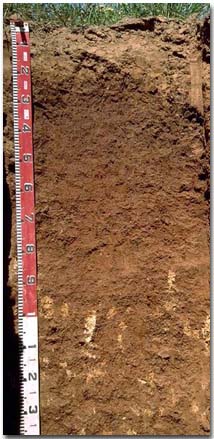LP96
Location: Gooroc
Australian Soil Classification: Calcic, Mesonatric, Red SODOSOL
Northcote Factual Key: Dr 2.33
Great Soil Group: red-brown earth
General Landscape Description: Flood plain of Avoca River.
 Site LP96 Landscape |
Soil Profile Morphology:
Surface Soil
| A1 | 0-10 cm | Brown (7.5YR4/4); heavy fine sandy loam; structureless; firm consistence dry; pH 6.6; clear change to: |  Site LP96 Profile |
| A2 | 10-20 cm | Yellowish red (5YR5/6) pink (5YR8/3) sporadically bleached; fine sandy clay loam; structureless; strong consistence dry; pH 6.9; sharp change to: | |
| Subsoil | |||
| B21 | 20-40 cm | Reddish brown (5YR4/4); medium clay; smooth faced peds; strong coarse blocky structure; firm consistence moderately moist; pH 8.2; clear change to: | |
| B31 | 40-70 cm | Yellowish red (5YR5/8); medium heavy clay; smooth faced peds; moderate coarse blocky structure; firm consistence, moderately moist; pH 8.9; gradual change to: | |
| B32 | 70-90 cm | Yellowish red (5YR5/8); medium heavy clay; smooth faced peds; moderate coarse blocky structure; very firm consistence moderately moist; pH 9.2; gradual change to: | |
| B33k | 90-150 cm | Yellowish red (5YR5/8); medium clay; smooth faced peds; moderate coarse blocky, parting to moderate medium polyhedral structure; very firm consistence, moderately moist; contains a few (5-10%) soft carbonates and a few (2%) carbonate nodules (4-10 mm size) and very few (< 2%) dark manganese stains (< 2mm size); pH 9.3. | |
Key Profile Features:
- Strong texture contrast between surface (A) horizons (< 21 % clay) and subsoil (B21) horizon (51 % clay).
Soil Profile Characteristics:
pH | Salinity Rating | |||
Surface (A1 horizon) | slightly acid | very low | non-sodic | none 1 |
Subsoil (B21 horizon) | moderately alkaline | very low | strongly sodic | strong |
Deeper subsoil (at 1 m) | very strongly alkaline | low-medium | strongly sodic | - |

Management Considerations:
Whole Profile
- Plant available water capacity (PAWC) is considered to be very low (estimated at 35 mm). This is based on available laboratory data and assumes an effective rooting depth of 30 cm. Rooting depth will be restricted by the hard A2 horizon and by the strongly sodic subsoil.
- The surface soil is non-sodic but disperses slightly when remoulded. This indicates that dispersion and resultant structural degradation (eg. exacerbated hardsetting, surface sealing) may occur if the soil is cultivated in a moist to wet condition. Raindrop action on bare soil can have a similar effect, so surface cover should be maintained.
- The surface soil has a high fine sand (45%) and silt (19%) content. Such soils rely on organic matter for maintaining soil aggregation and preventing slaking.
- The subsurface (A2) horizon is sodic and disperses moderately. Complete dispersion occurs after remoulding which indicates that this horizon is liable to develop into a hardpan if cultivated whilst in a moist to wet condition. This horizon is very hard and seems to be restricting root movement. The soil below is moist which indicates that roots are unable to utilise the moisture due to being restricted in this subsurface horizon. Ripping of this horizon together with gypsum application may be an effective ameliorative technique. A test strip could be used to assess likely benefits. Alternatively, using plants with a strong tap root (eg. safflower) to force through the compacted layer can leave channels for subsequent plant roots to use.
- The upper subsoil is strongly sodic and dispersive as well as having a low exchangeable calcium:magnesium ratio (ie. <1). This indicates that root and water movement will be restricted in the subsoil. Waterlogging may occur above the subsoil after heavy rains as a result.
- The deeper subsoil (below 40 cm depth) becomes strongly alkaline. This indicates that some nutrients (eg. iron, manganese, copper, zinc) may be poorly available to plants at depth.
- Soluble salt levels increase with depth in the subsoil but only reach a low to moderate level at 1 metre depth. Plant growth is unlikely to be affected as a result.
Comments from Landholder:
- Most responsive paddock to direct drilling and stubble retention; now yielding as well as "black ground" paddocks.
- Lupins grown here at time of sampling. Have had little success with lupins. Possibly due to high pH in subsoil.
- Paddock currently sown to safflower in an attempt to break the hard pan below the surface.
- Floods here occasionally.
Profile Described By: Mark Imhof, Paul Rampant, Karen DePlater (14/11/1995).


